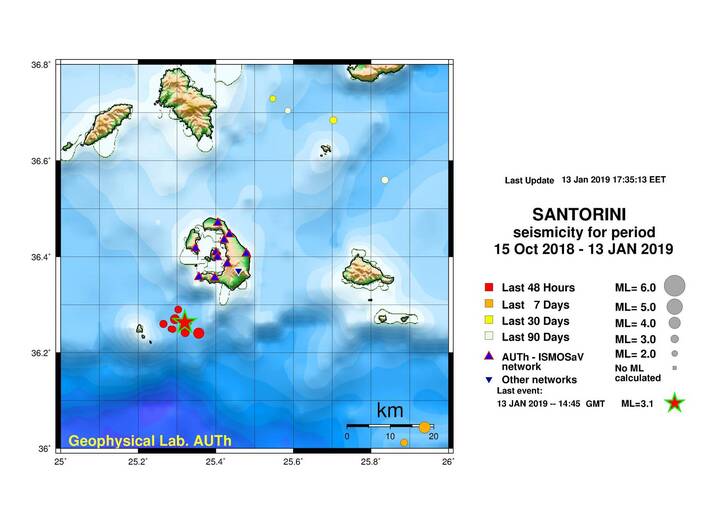Santorini Quakes: Current Trends And Future Outlook

Table of Contents
Recent Seismic Activity on Santorini
Santorini experiences regular seismic activity, a constant reminder of its volcanic origins. The frequency and magnitude of these Santorini quakes vary, but careful monitoring provides valuable data. The Hellenic National Seismological Network (HN), for example, provides real-time data on seismic events.
- Average number of earthquakes per year: Santorini typically experiences hundreds of minor earthquakes annually, most too small to be felt by humans.
- Magnitude range of recorded earthquakes: The magnitude of recorded earthquakes ranges from minor tremors below magnitude 2.0 to occasionally stronger events exceeding magnitude 4.0.
- Locations of recent earthquake epicenters: Epicenters are often clustered around the caldera, reflecting the ongoing volcanic processes.
- Examples of minor tremors felt by residents and tourists: Minor tremors are sometimes felt by locals and tourists, serving as a subtle yet persistent reminder of the island’s dynamic geological setting. These events, while generally not destructive, can be unsettling.
Geological Factors Contributing to Santorini Earthquakes
The geological context of Santorini is paramount to understanding its seismic activity. The island is part of a volcanic arc formed by the subduction of the African plate beneath the Aegean plate. This tectonic setting generates considerable stress and pressure within the Earth's crust.
- Santorini's volcanic history: Santorini's history is punctuated by powerful volcanic eruptions, most notably the Minoan eruption around 1600 BC, which dramatically shaped the island's current caldera.
- Plate tectonics influencing the region: The ongoing interaction of the African and Aegean plates creates a complex stress field, leading to frequent faulting and magma movement.
- Caldera's structure and instability: The caldera itself is a large, partially submerged volcanic crater, constantly adjusting to changes in pressure beneath. This instability is a major contributor to Santorini quakes.
- Impact of magma chamber pressure: Fluctuations in pressure within the magma chamber beneath Santorini trigger earthquakes as the crust adjusts to these changes. Hydrothermal activity further contributes to crustal instability.
Monitoring and Prediction Efforts
A network of seismic stations and GPS measurement points constantly monitors Santorini's seismic activity. This provides valuable data for assessing current risks and improving future predictions. However, precise earthquake prediction remains a significant challenge.
- Types of monitoring technology used: The monitoring network uses a range of sophisticated technologies, including seismometers, tiltmeters, and GPS receivers, to detect and analyze ground movement.
- Data analysis methods employed: Sophisticated data analysis techniques are used to interpret the vast amounts of data collected, helping scientists to understand patterns and potentially identify precursors to larger seismic events.
- Challenges in accurately predicting earthquakes: Predicting the precise timing and magnitude of earthquakes remains elusive. While scientists can assess probabilities, pinpointing the exact occurrence is currently impossible.
- Future advancements in seismic monitoring: Ongoing research focuses on improving monitoring techniques and developing better predictive models using advanced algorithms and artificial intelligence.
Public Awareness and Safety Measures
Public education plays a vital role in mitigating the risks associated with Santorini's seismic activity. Preparedness is key.
- Recommendations for earthquake preparedness kits: Residents and tourists should have readily accessible emergency kits containing essential supplies, including water, food, a first-aid kit, and a flashlight.
- Safety guidelines during and after an earthquake: Knowing what to do during and after an earthquake is crucial. This includes “drop, cover, and hold on” techniques and post-quake safety procedures.
- Information about building codes designed to withstand earthquakes: Stringent building codes and construction standards are crucial for ensuring that structures can withstand seismic activity.
Future Outlook and Potential Risks
Long-term predictions for Santorini seismic activity rely heavily on historical patterns and ongoing geological monitoring. The potential risks to infrastructure, tourism, and the population are significant.
- Probability assessments of future earthquakes: While pinpointing specific events is impossible, statistical models can assess the probabilities of earthquakes of different magnitudes occurring over various timeframes.
- Potential impacts of different magnitude earthquakes: Larger earthquakes could cause significant damage to buildings, infrastructure, and potentially trigger landslides.
- Long-term strategies for risk mitigation: Long-term strategies include improving building codes, developing evacuation plans, and investing in early warning systems.
- Calls for improved infrastructure resilience: Strengthening infrastructure is paramount. This includes retrofitting existing structures and using earthquake-resistant materials in new construction.
Conclusion
Understanding Santorini quakes is crucial for ensuring the safety and well-being of the island's residents and visitors. While precise earthquake prediction remains a scientific challenge, ongoing monitoring and research are essential for assessing and mitigating risks. We must remember that preparedness and responsible planning are key to minimizing the impact of future seismic events. Stay informed about the latest information on Santorini seismic activity and earthquake preparedness measures via official sources like the Hellenic National Seismological Network. By working together, we can ensure Santorini remains a beautiful and safe destination for years to come.

Featured Posts
-
 Thomas Muellers Farewell His Most Frequent Playing Partners At Bayern Munich
May 11, 2025
Thomas Muellers Farewell His Most Frequent Playing Partners At Bayern Munich
May 11, 2025 -
 Henry Goldings Excitement For The Crazy Rich Asians Tv Series A Deep Dive
May 11, 2025
Henry Goldings Excitement For The Crazy Rich Asians Tv Series A Deep Dive
May 11, 2025 -
 De Schoonheid Van Sylvester Stallones Dochter Een Nieuwe Foto
May 11, 2025
De Schoonheid Van Sylvester Stallones Dochter Een Nieuwe Foto
May 11, 2025 -
 Tracking The Injuries Yankees Brewers Series March 27 30
May 11, 2025
Tracking The Injuries Yankees Brewers Series March 27 30
May 11, 2025 -
 Houston Astros Foundation College Classic 2024 Schedule Tickets And More
May 11, 2025
Houston Astros Foundation College Classic 2024 Schedule Tickets And More
May 11, 2025
